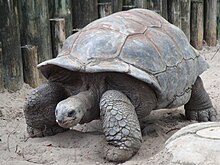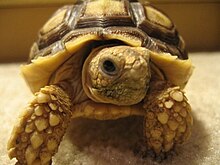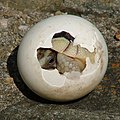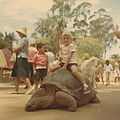Tortoise: Difference between revisions
VMS Mosaic (talk | contribs) m →Gallery: minor fixes |
→Taxonomy: Fixed an error. I corrected to where the link went due to the fact the genus page says the same thing as the link |
||
| Line 74: | Line 74: | ||
*'''''[[Chelonoidis]]''''' Fitzinger, 1835. |
*'''''[[Chelonoidis]]''''' Fitzinger, 1835. |
||
**''[[Red-footed tortoise|Chelonoidis carbonaria]]'', Red-footed Tortoise |
**''[[Red-footed tortoise|Chelonoidis carbonaria]]'', Red-footed Tortoise |
||
**''[[Argentine Tortoise|Chelonoidis chilensis]]'', |
**''[[Argentine Tortoise|Chelonoidis chilensis]]'', Argentine Tortoise |
||
**''[[Brazilian Giant Tortoise|Chelonoidis denticulata]]'', Yellow-Footed Tortoise |
**''[[Brazilian Giant Tortoise|Chelonoidis denticulata]]'', Yellow-Footed Tortoise |
||
**''[[Galápagos tortoise|Chelonoidis nigra]]'', Galápagos Giant Tortoise |
**''[[Galápagos tortoise|Chelonoidis nigra]]'', Galápagos Giant Tortoise |
||
Revision as of 20:46, 13 April 2012
| Tortoises | |
|---|---|

| |
| An Aldabra Giant Tortoise (Aldabrachelys gigantea) | |
| Scientific classification | |
| Domain: | Eukaryota |
| Kingdom: | Animalia |
| Phylum: | Chordata |
| Class: | Reptilia |
| Order: | Testudines |
| Suborder: | Cryptodira |
| Superfamily: | Testudinoidea |
| Family: | Testudinidae Gray 1825[1] |
Tortoises (/[invalid input: 'icon']ˈtɔːr.təs.ɪz/, Testudinidae) are a family of land-dwelling reptiles of the order of turtles (Testudines). Like their marine cousins, the sea turtles, tortoises are shielded from predators by a shell. The top part of the shell is the carapace, the underside is the plastron, and the two are connected by the bridge. The tortoise has both an endoskeleton and an exoskeleton. Tortoises can vary in size from a few centimeters to two meters. Tortoises are usually diurnal animals with tendencies to be crepuscular depending on the ambient temperatures. They are generally reclusive animals.
Use of the term "tortoise"

Although the word is used by biologists in reference to the family Testudinidae only, in colloquial usage it is often used to describe many land-dwelling turtles. The inclusiveness of the term depends on the variety of English being used.[2]
- British English normally describes these reptiles as "tortoises" if they live on land.
- American English tends to use the word "tortoise" for land-dwelling species, including members of Testudinidae, as well as other species such as box tortoises, though use of "turtle" for all chelonians is as common.
- Australian English uses "tortoise" for terrestrial species, including semi-aquatic species that live near ponds and streams. Traditionally, a "tortoise" has feet (including webbed feet) while a "turtle" has flippers.
Biology
Birth

Female tortoises dig nesting burrows in which they lay from one to thirty eggs.[3] Egg laying typically occurs at night, after which the mother tortoise covers her clutch with sand, soil, and organic material. The eggs are left unattended, and depending on the species, take from 60 to 120 days to incubate.[4] The size of the egg depends on the size of the mother and can be estimated by examining the width of the cloacal opening between the carapace and plastron. The plastron of a female tortoise often has a noticeable V-shaped notch below the tail which facilitates passing the eggs. Upon completion of the incubation period, a fully formed hatchling uses an egg tooth to break out of its shell. It digs to the surface of the nest and begins a life of survival on its own. Hatchlings are born with an embryonic egg sac which serves as a source of nutrition for the first 3 to 7 days until they have the strength and mobility to find food. Juvenile tortoises often require a different balance of nutrients than adults, and therefore may eat foods which a more mature tortoise would not. For example, it is common that the young of a strictly herbivorous species will consume worms or insect larvae for additional protein.
Lifespan

The number of concentric rings on the carapace, much like the cross-section of a tree can sometimes give a clue on how old the animal is, but, since the growth of a tortoise depends highly on the accessibility of food and water; a tortoise that has access to plenty of forage (or is regularly fed by its owner) with no seasonal variation will have no noticeable rings. Moreover, some tortoises grow more than one ring per season and in some others, due to wear, some rings are no longer visible.[5]
Tortoises generally have lifespans comparable with those of human beings, and some individuals are known to have lived longer than 150 years. Because of this, they symbolize longevity in some cultures, such as China. The oldest tortoise ever recorded, and one of the oldest individual animals ever recorded, was Tu'i Malila, which was presented to the Tongan royal family by the British explorer Captain Cook shortly after its birth in 1777. Tui Malila remained in the care of the Tongan royal family until its death by natural causes on May 19, 1965. This means that upon its death, Tui Malila was 188 years old.[6] The record for the longest-lived vertebrate is exceeded only by one other, a koi named Hanako whose death on July 17, 1977 ended a 226-year life span.[7][dead link]
The Alipore Zoo in India was the home to Adwaita, which zoo officials claimed was the oldest living animal until its death on March 23, 2006. Adwaita (sometimes spelled with two d's) was an Aldabra Giant Tortoise brought to India by Lord Wellesley who handed it over to the Alipur Zoological Gardens in 1875 when the zoo was set up. Zoo officials state they have documentation showing that Adwaita was at least 130 years old, but claim that he was over 250 years old (although this has not been scientifically verified). Adwaita was said to be the pet of Robert Clive.[8]
Harriet was a resident at the Australia Zoo in Queensland from 1987 to her death in 2006, it was believed that she was brought to England by Charles Darwin aboard the Beagle and then on to Australia by John Clements Wickham.[9][10] Harriet died on June 23, 2006, just shy of her 176th birthday.
Timothy, a spur-thighed tortoise, lived to be approximately 165 years old. For 38 years she was carried as a mascot aboard various ships in Britain's Royal Navy. Then in 1892, at age 53 she retired to the grounds of Powderham Castle in Devon. Up to the time of her death in 2004 she was believed to be the United Kingdom's oldest resident.
According to articles published by the Daily Mail and the Times in December 2008, Jonathan, a Seychelles Giant tortoise living on the island of St Helena may be as old as 176[11] or 178 years.[12] If this is true, he could be the current oldest living animal on Earth.
Sexual dimorphism
Many species of tortoises are sexually dimorphic, though the differences between males and females vary from species to species. In some species, males have a longer, more protruding neck plate than their female counterparts, while in others the claws are longer on the females. In most tortoise species, the female tends to be larger than the male. The male also has a plastron that is curved inwards to aid reproduction. The easiest way to determine the sex of a tortoise is to look at the tail. The females, as a general rule have a smaller tail which is dropped down whereas the males have a much longer tail which is usually pulled up and to the side of the rear shell.
General information
Giant tortoises move very slowly on dry land, at only 0.17 miles per hour (0.27 km/h).[13]
Diet

Most land based tortoises are herbivores, feeding on grazing grasses, weeds, leafy greens, flowers, and some fruits although there are some omnivorous species in this family. Pet tortoises typically require a diet based on wild grasses, weeds, leafy greens and certain flowers. Certain species consume worms or insects and carrion in their normal habitat. Too much protein is detrimental in herbivorous species and has been associated with shell deformities and other medical problems. As different tortoise species vary greatly in their nutritional requirements it is essential to thoroughly research the dietary needs of an individual tortoise.
Taxonomy
The following species list largely follows Rhodin et al., 2010,[14] this is a work in progress.



Family Testudinidae Batsch 1788[16]
Subfamily Testudininae
- Aldabrachelys
- Aldabrachelys gigantea gigantea, Aldabra Giant Tortoise, common synonyms Geochelone gigantea, Dipsochelys gigantea
- Aldabrachelys gigantea arnoldi, Arnold's Giant Tortoise,
- Aldabrachelys gigantea daudinii (Extinct)
- Aldabrachelys gigantea hololissa, Seychelles Giant Tortoise
- Aldabrachelys abrupta (Extinct)
- Aldabrachelys grandidieri (Extinct)
- Astrochelys Gray, 1873
- Astrochelys radiata, Radiated Tortoise
- Astrochelys yniphora, Angulated Tortoise, Madagascan (Plowshare) Tortoise
- Chelonoidis Fitzinger, 1835.
- Chelonoidis carbonaria, Red-footed Tortoise
- Chelonoidis chilensis, Argentine Tortoise
- Chelonoidis denticulata, Yellow-Footed Tortoise
- Chelonoidis nigra, Galápagos Giant Tortoise
- Chelonoidis petersi, Chaco Tortoise
- Chersina
- Chersina angulata, Bowsprit Tortoise
- Colossochelys
- Colossochelys atlas, Atlas Tortoise (Extinct)
- Cylindraspis (All species Extinct) Following Austin and Arnold, 2001.[17]
- Cylindraspis indica, synonym Cylindraspis borbonica
- Cylindraspis inepta
- Cylindraspis peltastes
- Cylindraspis triserrata
- Cylindraspis vosmaeri
- Geochelone
- Geochelone elegans, Indian Star Tortoise
- Geochelone platynota, Burmese Star Tortoise
- Geochelone sulcata, African Spurred Tortoise (Sulcata Tortoise)
- †Hadrianus
- Hadrianus corsoni (syn. H. octonarius)
- Hadrianus robustus
- Hadrianus schucherti
- Hadrianus utahensis
- Homopus
- Homopus areolatus, Beaked Cape Tortoise or Parrot-beaked Cape Tortoise
- Homopus boulengeri, Boulenger's Cape Tortoise
- Homopus femoralis, Karroo Cape Tortoise
- Homopus signatus, Speckled Cape Tortoise, Speckled Padloper
- Homopus bergeri, Berger's Cape Tortoise, Nama Padloper, synonym Homopus solus
- Indotestudo
- Indotestudo elongata, Elongated Tortoise
- Indotestudo forstenii, Travancore Tortoise, Forsten’s Tortoise
- Indotestudo travancorica, Travancore Tortoise
- Kinixys
- Kinixys belliana, Bell's Hinge-back Tortoise
- Kinixys erosa, Serrated Hinge-back Tortoise
- Kinixys homeana, Home's Hinge-back Tortoise
- Kinixys lobatsiana, Lobatse Hinge-back Tortoise
- Kinixys natalensis, Natal Hinge-back Tortoise
- Kinixys spekii, Speke's Hinge-back Tortoise
- Malacochersus
- Malacochersus tornieri, Pancake Tortoise
- Psammobates
- Psammobates geometricus, Geometric Tortoise
- Psammobates oculifer, Serrated Star Tortoise
- Psammobates tentorius, African Tent Tortoise
- Pyxis
- Pyxis arachnoides, Madagascan Spider Tortoise
- Pyxis planicauda, Madagascan Flat-tailed Tortoise
- Stigmochelys Gray, 1873
- Stigmochelys pardalis, Leopard Tortoise
- Testudo
- Testudo graeca, Greek Tortoise (Spur-thighed Tortoise)
- Testudo hermanni, Herman's Tortoise
- Testudo horsfieldii, Russian Tortoise (Horsfield's Tortoise, or Central Asian Tortoise)
- Testudo kleinmanni, Egyptian Tortoise, incl. Negev Tortoise
- Testudo marginata, Marginated Tortoise
Subfamily Xerobatinae Agassiz, L. 1857.[18]
- Gopherus
- Gopherus agassizii, Desert Tortoise
- Gopherus berlandieri, Texas Tortoise
- Gopherus flavomarginatus, Bolson Tortoise
- Gopherus polyphemus, Gopher Tortoise
- Manouria
- Manouria emys, Brown Tortoise (Mountain Tortoise)
- Manouria impressa, Impressed Tortoise
- Stylemys (Genus extinct)
- Stylemys botti
- Stylemys calaverensis
- Stylemys canetotiana
- Stylemys capax
- Stylemys conspecta
- Stylemys copei
- Stylemys emiliae
- Stylemys frizaciana
- Stylemys karakolensis
- Stylemys nebrascensis (syn. S. amphithorax)
- Stylemys neglectus
- Stylemys oregonensis
- Stylemys pygmea
- Stylemys uintensis
- Stylemys undabuna
In religion

In Hinduism, Kurma (Sanskrit: कुर्म) was the second Avatar of Vishnu. Like the Matsya Avatara also belongs to the Satya Yuga. Vishnu took the form of a half-man half-tortoise, the lower half being a tortoise. He is normally shown as having four arms. He sat on the bottom of the ocean after the Great Flood. A mountain was placed on his back by the other gods so that they could churn the sea and find the ancient treasures of the Vedic peoples. Tortoise shells were used by ancient Chinese as Oracle Bones to make predictions.
Cultural depictions
Gallery
-
A baby Testudo marginata emerges from its egg
-
A baby tortoise, less than a day old
-
Testudo graeca ibera, Testudo hermanni boettgeri, Testudo hermanni hermanni, Testudo marginata sarda
-
A young (3.5 years) Sulcata Tortoise Geochelone sulcata
-
A young, 20 year old Tanzanian Leopard Tortoise feeding on grass
-
Aldabra Giant Tortoise Geochelone gigantea
-
A 22 year old Leopard Tortoise
-
An African Spurred Tortoise from the Oakland Zoo
-
Pair of tortoises mate in a zoo
-
A boy rides a tortoise at a zoo
See also
References
- ^ Gray, J.E. "A synopsis of the genera of reptiles and amphibia, with a description of some new species". Annals of Philosophy. 2 (10): 193–217.
- ^ "Turtle" at sandiegozoo.org
- ^ Andy Highfield. "Tortoise Trust Egg F.A.Q". Tortoisetrust.org. Retrieved 2009-04-07.
- ^ Andy Highfield. "Tortoise egg incubation". Tortoisetrust.org. Retrieved 2009-04-07.
- ^ Veterinary Services Department, Drs. Foster & Smith, Inc. "Shells: Anatomy and Diseases of Turtle and Tortoise Shells". Retrieved 20 December 2011.
{{cite web}}: CS1 maint: multiple names: authors list (link) - ^ "Tortoise Believed to Have Been Owned by Darwin Dies at 176 - Science News | Science & Technology | Technology News". FOXNews.com. 2006-06-26. Retrieved 2009-04-07.
- ^ Hanako
- ^ "World | South Asia | 'Clive of India's' tortoise dies". BBC News. 2006-03-23. Retrieved 2009-04-07.
- ^ Thomson, S., S. Irwin, and T. Irwin. 1995. Harriet, the Galapagos tortoise: disclosing one and a half centuries of history. Intermontanus 4 (5):33–35.
- ^ Thomson, S., S. Irwin, and T. Irwin. 1996. Harriet: La tortuga de Galápagos. Reptilia 2 (4):46–49.
- ^ Jonathan the 176-year-old tortoise revealed as world's oldest animal in Boer War photo Daily Mail, December 5, 2008
- ^ Boer War memento puts years on Jonathan the tortoise. The Times, December 4, 2008
- ^ 2003 Grolier Encyclopedia, The Great Book of Knowledge, The Speed of Animals, pp. 278
- ^ Anders G.J. Rhodin, Peter Paul van Dijk, John B. Iverson, and H. Bradley Shaffer. 2010. Turtles of the World, 2010 Update: Annotated Checklist of Taxonomy, Synonymy, Distribution, and Conservation Status
- ^ http://eobatagur.ifrance.com/pub/claudetong1.pdf
- ^ Batsch, A.J.G.C. 1788. Versuch einer Anleitung zur Kenntniss und Geschichte der Thiere und Mineralien. Erster Theil. Allgemeine Geschichte der Natur; besondre der Säugthiere, Vögel, Amphibien und Fische. Jena: Akademischen Buchandlung, 528 pp.
- ^ Austin, J.J., Arnold, E.N. 2001 Ancient mitochondrial DNA and morphology elucidate an extinct island radiation of Indian Ocean giant tortoises (Cylindraspis). Proceedings: Biological Sciences, Volume 268, Number 1485, Pages: 2515-2523.
- ^ Agassiz, L. 1857. Contributions to the natural history of the United States of America. Vol. 1. Little, Brown and Co., Boston. 452p.
Further reading
- Chambers, Paul (2004). A Sheltered Life: The Unexpected History of the Giant Tortoise. London: John Murray. ISBN 0-7195-6528-6.
{{cite book}}: Cite has empty unknown parameter:|coauthors=(help) - Ernst, C. H. (1989). Turtles of the World. Washington, DC: Smithsonian Institution Press.
{{cite book}}: Unknown parameter|coauthors=ignored (|author=suggested) (help) - Gerlach, Justin (2004). Giant Tortoises of the Indian Ocean. Frankfurt: Chimiara.
{{cite book}}: Cite has empty unknown parameter:|coauthors=(help) - Kuyl, Antoinette C. van der; Ph Ballasina, DL; Dekker, JT; Maas, J; Willemsen, RE; Goudsmit, J (2002). "Phylogenetic Relationships among the Species of the Genus Testudo (Testudines: Testudinidae) Inferred from Mitochondrial 12S rRNA Gene Sequences". Molecular Phylogenetics and Evolution. 22 (2): 174–183. doi:10.1006/mpev.2001.1052. ISSN 1055-7903. PMID 11820839.
{{cite journal}}: More than one of|first1=and|first=specified (help); More than one of|last1=and|last=specified (help); Unknown parameter|coauthors=ignored (|author=suggested) (help); Unknown parameter|month=ignored (help)
External links
- The Reptile Database
- Family Testudinidae (Tortoises) of The Reptile Database
- Tortoise Protection Group: Tortoise conservation information
- Chelonia: Conservation and care of turtles.











